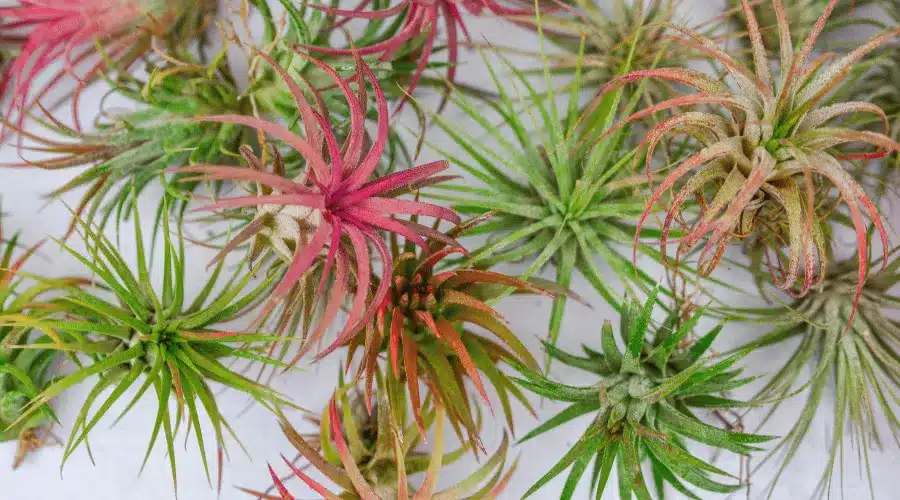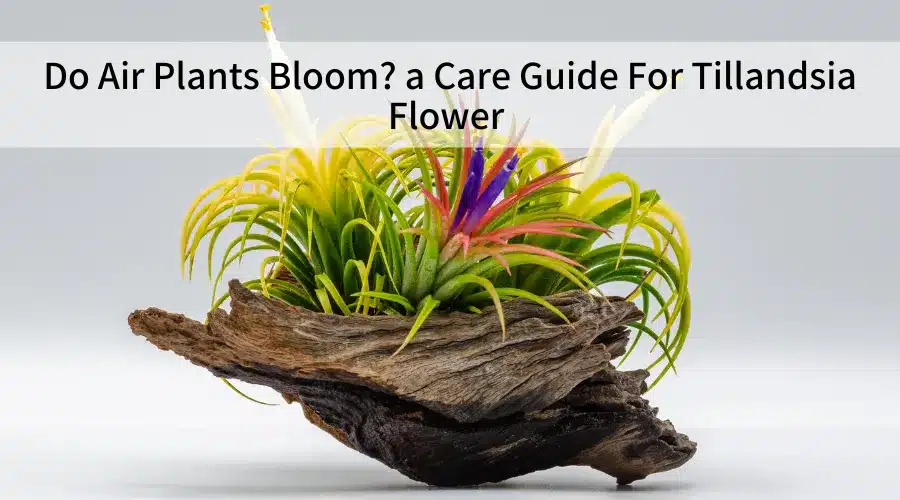If you’ve ever found yourself marveling at the surreal beauty of air plant blooms, you’re in for a treat! These enchanting bursts of color amidst a sea of lush green foliage are like nature’s way of showing off its artistic flair. Among the plethora of fascinating tillandsia species, the Tillandsia ionantha stands out as a rockstar when putting on a floral spectacle. But hold your gardening horses, as proper care is the key to coaxing those delightful blooms out of your new air plants. Whether you’re a green-thumbed guru or just starting your leafy journey, join us as we dive into the captivating world of air plant blooms and the secrets to making them flourish like never before.
There are species of air plants that certainly know how to steal the spotlight with their mesmerizing and beautiful blooms. Picture this: a blooming air plant becomes the vibrant center of attention, flaunting its unique blooms like a botanical work of art. But how does this enchanting blooming process unfold? Well, air plants follow a fascinating blooming cycle that’s a bit different from your typical garden blooms. Instead of producing many flowers simultaneously, they focus on a single bloom spike, extending their blooming period gracefully. To witness this blooming spectacle, creating the right conditions – a blend of proper lighting, humidity, and care – to support the plant throughout its unique blooming cycle is crucial. So, if you’ve ever wondered about the secrets behind the captivating blooming process of air plants, join us as we unravel the mysteries and share tips to help you nurture your blooming air plant masterpiece right at home.
Air plants: what are they?
Scientifically known as Tillandsia, air plants are a fascinating group that defies the conventional norms of plant care. Unlike their soil-bound counterparts, air plants are epiphytes, which means they don’t need to be planted in the soil to grow. Instead, they gather nutrients and moisture from the air around them. This unique feature allows them to cling to various surfaces, making them perfect candidates for creative and artistic displays.
Native to regions such as Central and South America and parts of the southern United States, air plants have adapted to a wide range of environments, from humid rainforests to arid deserts. They come in an array of shapes, sizes, and textures, showcasing the diversity of the plant kingdom. Some air plants have wispy, delicate leaves, while others boast sturdy, sculptural forms.
One of the most intriguing aspects of air plants is their blooming ability. Just like their name suggests, these plants produce vibrant and eye-catching blooms that burst forth from the heart of the plant. A bloom cycle is a thrilling event in an air plant’s life, often marking its growth’s culmination.
Caring for air plants is an adventure in itself. While they might not need soil, they do require a little TLC. Light, water, and humidity play crucial roles in their well-being. Providing them with the right balance of these elements is essential to help them thrive. Placing them in locations with bright, indirect light, misting or soaking them regularly, and ensuring adequate humidity levels are all part of the care routine that allows air plants to flourish.
Whether you’re a seasoned plant enthusiast or just starting your plant journey, air plants offer an exciting and unique addition to your botanical collection. Their ability to defy gravity, adapt to various environments, and put on stunning displays of color make them a captivating choice for any indoor garden. So, if you’re ready to explore the world of plants that don’t play by the rules, air plants are waiting to take you on an enchanting journey.
Air Plant Care Guide: Nurturing Your Blooming Beauties

Finding the Perfect Spotlight: Light Requirements
Air plants, those enchanting little botanical wonders, have their preferences when it comes to lighting. Think of them as divas who adore the spotlight but are particular about its intensity. Sufficient light is their key to success, but they’re not fans of too much of a good thing – much direct sunlight can scorch their delicate leaves. Instead, opt for bright indirect light or a cozy spot with enough sunlight filtered through a curtain. In drier climates or during winter, they might long for some tropical vibes – a dry climate isn’t their jam. On the other hand, if you’re lucky enough to dwell in humid environments, their leaves will happily soak in moisture. Remember, finding the balance is like striking gold for these green darlings.
Quenching Their Thirst: Watering Wisely
Water is the elixir of life for plants, but air plants are slightly different. Much water might sound like a good idea, but it’s a no-go. Forget about drowning them in a deluge of tap water; it won’t end well. Excess water can lead to rot; trust us, that’s a garden tragedy you want to avoid. The air is your plant’s hydration haven for those in tropical climates or humid homes. But in drier climates, they might occasionally need a drink. A good rule of thumb: mist them a couple of times a week or give them a quick soak (10-30 minutes) every two weeks. After refreshing soak, let them dry upside-down to prevent water from getting trapped at the base.
Setting the Stage: Temperature and Humidity
Like actual celebrities, air plants have their comfort zone regarding temperature. They’re happy at the same room temperature you are and can handle a slight dip during the night. And oh, humidity – these plants are the drama queens of the plant world regarding moisture. In humid environments, they thrive like champs, soaking up the moisture in the air. For other locales, you might want to give them a spa day now and then. Placing them in a bathroom or near other plants can up the humidity levels they crave. If you’re one of those meticulous air plant enthusiasts, you can even use a humidity tray. Just remember, happy humidity equals happy blooms.
Feeding Their Passion: Fertilizing Finesse
Ah, the secret sauce to a flourishing air plant: fertilization. Just like a balanced diet, air plants benefit from a little boost of nutrients. But here’s the trick: they’re not voracious eaters. A diluted, low-nitrogen liquid fertilizer is your go-to, and we’re talking every 3-4 weeks during their growing season (typically spring to fall). Gently mist or dunk them in the diluted solution, and remember – moderation is the name of the game. Overdoing it might lead to a nutrient overload, and nobody wants that. So, let your air plants dine on a carefully curated meal plan, and they’ll reward you with some seriously stunning blooms.
Propagation of air plants

Air plant pups are the best way to propagate air plants. These baby air plants, often a result of the natural growth cycle in their natural habitat, can be separated from the mother plant’s base and grown into new plants. The growth rate of these pups is impressive as they quickly develop their own set of leaves and roots.
To propagate using pups, gently detach them from the mother plant’s base. Allow them to dry for a day or two to prevent rot, then consider various creative planting methods – from securing them with non-toxic glue to placing them on driftwood or in decorative holders. Just remember, the size of the mother plant doesn’t necessarily dictate the size of the pups; air plants have a unique life cycle, and their growth can surprise you.
Caring for these new additions requires the proper care, similar to mature air plants. Adequate lighting, regular misting or soaking, and proper air circulation are vital. Providing indirect sunlight is generally beneficial, especially as these pups develop. And here’s a caution: while pups can be exciting to propagate, don’t rush to separate them from the mother plant too soon. Allowing them to grow a bit ensures they have the strength to thrive independently.
In essence, air plant pups open up a world of possibilities to expand your collection and nurture varieties of air plants. You can nurture an entire family of air plants from a single mature plant, each with its unique growth journey. So, whether you’re a propagation novice or a seasoned gardener, embracing the propagation process adds another wonder to the captivating world of air plants.
Air Plants: FAQ
Not all air plant varieties will bloom during their lifetime. Blooming depends on factors like species, age, and care conditions. Some, like Tillandsia ionantha, are known for frequent blooms and producing beautiful flowers, while others, like Tillandsia xerographica, might bloom less often or once, revealing their colorful flowers in a rare display. Creating optimal conditions can increase blooming chances, but not all plants will do so due to their natural growth patterns. Remember, each air plant has its unique story, and while some may choose to put on a show with stunning blooms, others might focus their energy on different aspects of growth.
Air plants typically do not meet their end after the culmination of their flowering stage. Instead, they often continue their life cycle by producing offsets or “pups.” These newly formed offshoots serve as successors to the mature plant, ensuring the perpetuation of the species. While the mature plant may display indications of a gradual decline, this should not be misconstrued as a terminal state. With attentive and proper care, the mature plant has the potential to recover from this phase of decline and once again flourish. This highlights the inherent resilience of air plants. Consequently, while the flowering phase marks a notable stage in their growth, it is not the outcome of their existence, as diligent care can rejuvenate and sustain the plant’s vitality.
Recent Posts
Unlocking the secret to expanding your begonia maculata family is like discovering a treasure trove of green goodness. If you've ever marveled at the stunning beauty of angel wing begonia leaves and...
Known as a Schefflera plant, umbrella plants are low-maintenance plants frequently found in houseplants or outdoor gardens in warm climates. Even though Schefflera plants are easy to grow, they can...

